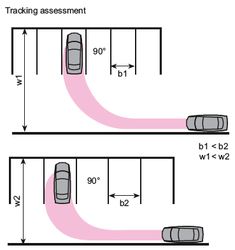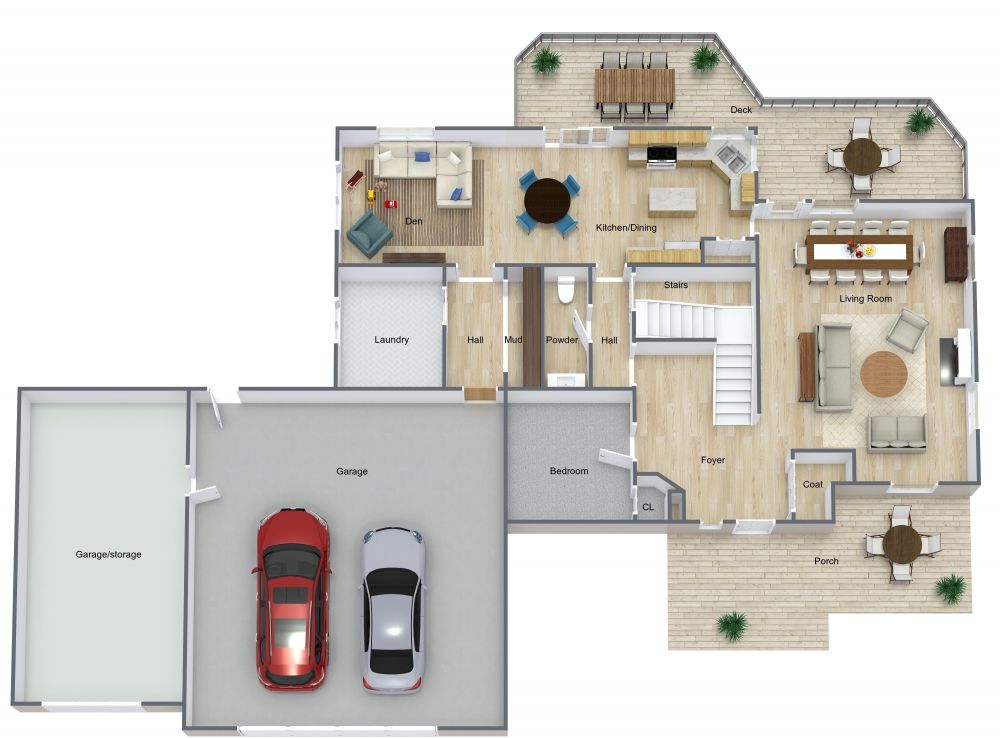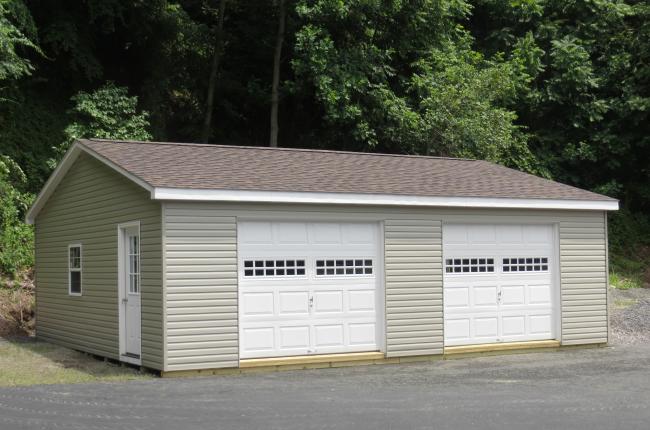
The garage is often the least used space in a home. It is full of junk, things, and appliances that aren't used often, as well occasional cars.
The idea of converting a two car garage into 2 bedrooms might sound crazy, but it can be a great way to add a new space to your home. It can boost your property's worth and make your home feel more spacious and comfortable.
A garage conversion can be a good idea for anyone who has a growing family, or if they are hoping to use the space to earn income. In fact, a $130,000 garage conversion that is rented out long-term can yield a 1.5 million dollar investment over a 30-year period.

French freelance photographer Fabre de Marien was having difficulty finding a place. So he transformed his abandoned garage into a chic bachelor pad with a one-bedroom. Fabre-de Marien, an architect, renovated the garage to create a modern, isolated home with all the necessary amenities for a single person.
The garage was converted into a living area that includes a kitchen, dining area, living and sleeping room, office, toilet, bathroom, bedroom, and a shower room. The minimalist design includes dark wood floors, a neutral palette, large windows and lots of natural lighting.
You should consider how the garage will be heated and cooled when it converts to a bedroom. It is likely you will need a new boiler or freestanding heaters. A floor covering cost and the costs of accessories and soft furnishings will be important.
It is also important you think about the layout, size, and shape of your new space. A professional contractor will help you plan your space in a way that works with the rest of your home. You can rely on information sources such GIS maps or county parcel maps to help you plan.

Cost of garage conversions depends on many factors, including the area to be converted, the work involved, and the materials used. You will also need to consider the type and size of the bathroom you would like in your new space.
Depending upon the design of your bedroom and bathroom, you may need to add both a roof and a door. It is also important to consider the amount of insulation that will be needed in order to keep the room warm and comfortable.
A good general contractor should be able give you a cost estimate and a quote. He or she can also help you choose the most comfortable and livable bedroom.
FAQ
What is the difference in a remodel and a renovaton?
Remodeling is making major changes to a particular room or area of a given room. A renovation refers to minor changes made to a particular room or area of a given room. A bathroom remodel can be a large project while an addition to a sink faucet can be a small project.
Remodeling is the process of changing a room or part of it. A renovation involves only changing a portion of a room. For example, a kitchen remodel involves replacing counters, sinks, appliances, lighting, paint colors, and other accessories. You could also update your kitchen by painting the walls, or installing new light fixtures.
What is the cost of remodeling a kitchen or bathroom?
Remodeling your bathroom or kitchen is expensive. It might be more cost-effective to upgrade your home than you think, given how much you spend each month on energy bills.
An inexpensive upgrade can save you thousands of dollars every year. A few small changes, such adding insulation to walls or ceilings, can cut down on heating and cooling costs. Even a modest addition can improve comfort and increase resale value.
Remember to choose durable and easy-to maintain products when you are planning your renovations. Materials like porcelain tile, solid wood flooring, and stainless-steel appliances will last longer and need fewer repairs than vinyl countertops.
You may also find that replacing old fixtures with newer models can help cut utility expenses. For example, installing low-flow showerheads and faucets can lower water usage by up to 50 percent. You can reduce your electricity consumption by replacing inefficient lighting bulbs with compact fluorescent lights.
How much does it cost for a shower to be tiled?
You might want to go big if you are going to do it yourself. A full bathroom remodels an investment. If you think about the long-term advantages of having a gorgeous space for years to follow, it makes good sense to invest quality fixtures.
The right tiles can make all the difference in how your space looks and feels. This guide will help you select the right tiles for your project, no matter how small or large.
Decide the type of flooring that you want to install. Common choices include ceramics and porcelain as well as stone and natural wooden. Next, pick a style like classic subway tiles or geometric designs. Select a color palette.
A large bathroom remodel will require you to match the tile in the room. You might choose white subway tiles in the bathroom and kitchen, but use darker colors in other rooms.
Next, calculate the project's size. Is it time to upgrade a small powder area? Do you want to add a walk-in wardrobe to your master bathroom?
After you have determined the scope of work, visit local shops to see samples. You can then get a feel of the product and how it is installed.
For great deals on porcelain tiles, you can shop online. Many retailers offer free shipping and discounts on bulk purchases.
What should I do about my cabinets?
It depends on whether you're considering selling your home or renting it out. If you are planning on selling, you might want to take out and refinish the cabinets. This gives buyers a feeling of newness and allows them to visualize their kitchens when they move in.
But if your goal is to rent your house you will need to remove the cabinets. Many renters complain about the dishes that are dirty and the greasy fingerprints left by tenants.
You can also consider painting the cabinets to make them look newer. Make sure to use high-quality primers and paints. Low-quality paints are susceptible to fading over time.
What is the difference between building a new home and gutting a current one?
Gutting a home involves removing everything within a building including walls and floors, ceilings as well as plumbing, electrical wiring, appliances, fixtures, and other fittings. This is usually done when you are moving into a new home and need to make some adjustments before you move in. Due to so many factors involved in the process of gutting a property, it can be very costly. Depending on the job, the average cost of gutting a home is between $10,000 and $20,000
Building a home means that a builder constructs a house piece by piece, then adds windows, doors, cabinets and countertops to it. This is usually done after buying a lot of lands. Building a home is typically cheaper than renovating, and usually costs between $15,000-30,000.
It really depends on your plans for the space. You will probably have to spend more to gut a house. If you're building your home, however, you don't have to tear everything down and start over. Instead of waiting for someone else, you can build it how you want.
What are the main components of a full kitchen renovation?
A complete kitchen remodel is more than just installing a new sink or faucet. There are also cabinets, countertops, appliances, lighting fixtures, flooring, plumbing fixtures, and much more.
A full kitchen remodel allows homeowners to update their kitchens without having to do any major construction. This means that no demolition is required, making the project easier for both the homeowner and the contractor.
There are many services that can be done to your kitchen, including plumbing, electrical, HVAC, painting, and carpentry. Depending on the scope of the project, multiple contractors might be needed to remodel a kitchen.
A team of professionals is the best way to ensure that a kitchen remodel runs smoothly. Kitchen remodels often involve many moving parts, and small issues can cause delays. If you choose a DIY approach, make sure you plan and have a backup plan in place in case things go wrong.
Statistics
- According to a survey of renovations in the top 50 U.S. metro cities by Houzz, people spend $15,000 on average per renovation project. (rocketmortgage.com)
- 57%Low-end average cost: $26,214Additional home value: $18,927Return on investment: (rocketmortgage.com)
- About 33 percent of people report renovating their primary bedroom to increase livability and overall function. (rocketmortgage.com)
- Following the effects of COVID-19, homeowners spent 48% less on their renovation costs than before the pandemic 1 2 (rocketmortgage.com)
- Windows 3 – 4% Patio or backyard 2 – 5% (rocketmortgage.com)
External Links
How To
How to Remove Tile Grout From Floor Tiles
Most people don’t know what tile grouting is. It seals the joints between tiles. There are many different types of grout today. Each has its own purpose. Here we will show you how to remove tile grout from floor tiles.
-
Before you begin, make sure you have everything you need. It is best to have a grout cutter, grout scraper, and some towels.
-
Now you need to start cleaning off any dirt or debris stuck under the tile. Use the grout knife to remove the grout. Scrape away any remaining grout. You must be careful not to scratch any tiles.
-
After everything is cleaned up, use the grout scraper for any remaining grout. If no grout is left over, you can proceed to step 4.
-
Now you can get on with the next step. Make sure to take one of the rags out and soak it in water. You want to make sure that the rag gets completely wet. Once the rag is wet, you can dry it by wringing the cloth.
-
Then, place the wet towel on the joint where tile meets wall. The grout will begin to crumble if you press down hard on the rag. Slowly pull your rag towards yourself and continue to pull it back and forth, until all grout is gone.
-
Repeat steps 4 to 5 until grout is gone. Rinse the ragout, and repeat the process if needed.
-
After you have removed grout, dry the tiles by wiping them with a damp cloth. Let dry thoroughly.